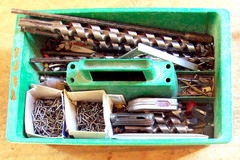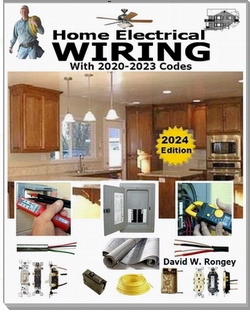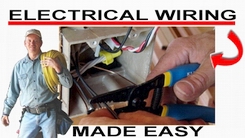» Home
» Electrical Wiring Directory
» Electrical Wiring Tools
» Need Electrical Help? Ask the Electrician
» Need Electrical Help? Ask the Electrician
Heavy Duty Cord Power Drills and Drill Bits
Electricians Tools for Electrical Work
|
|
By Dave Rongey
Summary: Here are some of the power tools and accessories I use when wiring a new home or a home remodel project. |
Drilling Holes for Installing Electrical Wiring
Example of Heavy Duty Electric Cord Power Drill and Drill Bits:
- Half Inch Right Angle Drill: Used for drilling wood framing to install electrical cable.
- Chip Auger Drill Bits: Drilling smaller holes using the right angle drill.
- Self Feeding Bits: Drill larger holes in wood using a heavy duty drill.
- Bi-Metal Hole Saws: Create various size holes in metal or wood.
 |
Rough-In Wiring Tool Tray |
Great for organizing:
|
|
|
||
Heavy Duty Right Angle Drill Motor with a Half Inch Chuck Typical Drill Bits: Installer Bit for data com cat3, cat5 or cat6 cable. Ship Auger Bits for installing cable. Self Feed Bit for large SER cable and conduit. Hole Saw for round light boxes. Chuck Key for tightening the bits. |
||
|
|
||
| 25 Foot Tape Measure | A wide tape measure with a lock is sturdy and will stay in place while making important measurements across a floor, wall, or ceiling. |
|
| Permanent Marker or Construction Crayola | Use for marking the location of Junction Boxes, Outlet and Switch Boxes, and Light Fixtures on wood framing. |
|
| Magnetic Speed Level | Do your level best to install any project accurately. |
|
| Plumb Bob | The good old fashioned plumb bob is handy for locating light fixtures above a table or counter, or above a floor layout. |
|
|
|||||||
| Electrical Wiring Tools Questions and Answers |
The Safest Way to Test Electrical Devices and Identify Electric Wires!The Non-Contact Electrical TesterThis is a testing tool that I have had in my personal electrical tool pouch for years, and is the first test tool I grab to help identify electrical wiring. It is a Non-contact tester that I use to easily Detect Voltage in Cables, Cords, Circuit Breakers, Lighting Fixtures, Switches, Outlets and Wires. Simply insert the end of the tester into an outlet, lamp socket, or hold the end of the tester against the wire you wish to test. Very handy and easy to use.
The Quickest Way to Check for Faulty Electrical Wiring!The Plug-In Outlet TesterThis is the first tool I grab to troubleshoot a problem with outlet circuit wiring. This popular tester is also used by most inspectors to test for power and check the polarity of circuit wiring. It detects probable improper wiring conditions in standard 110-125 VAC outlets Provides 6 probable wiring conditions that are quick and easy to read for ultimate efficiency Lights indicate if wiring is correct and indicator light chart is included Tests standard 3-wire outlets UL Listed Light indicates if wiring is incorrect Very handy and easy to use.
Strip Off Wire Insulation without Nicking and Damaging the Electric Wire!The Wire Stripper and Wire CutterMy absolute favorite wire stripping tool that I have had in my personal electrical tool pouch for years, and this is the tool I use to safely strip electrical wires. This handy tool has multiple uses: The wire gauges are shown on the side of the tool so you know which slot to use for stripping insulation. The end of the tool can be used to grip and bend wire which is handy for attaching wire onto the screw terminals of switches and outlets.. The wire stripper will work on both solid and stranded wire. This tool is Very Handy and Easy to Use. |
||
Residential Electrical Parts and AccessoriesLight Switches 120volt Outlets Circuit Breakers Electrician Tools Voltage Testers |















